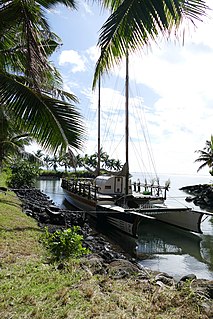Related Research Articles

The Boyd massacre occurred in December 1809 when Māori residents of Whangaroa Harbour in northern New Zealand killed between 66 and 70 European crew of the Boyd. Cannibalism was described or alluded to in contemporary reports. This is reputedly the highest number of Europeans killed by Māori in a single event in New Zealand. The massacre is thought to have been in revenge for the flogging for insubordination of a Māori chief's son by the crew of the Boyd.

Various Māori traditions recount how their ancestors set out from their homeland in waka hourua, large double-hulled ocean-going canoes (waka). Some of these traditions name a mythical homeland called Hawaiki.
Tākitimu was a waka (canoe) with whakapapa throughout the Pacific particularly with Samoa, the Cook Islands, and New Zealand in ancient times. In several Māori traditions, the Tākitimu was one of the great Māori migration ships that brought Polynesian migrants to New Zealand from Hawaiki. The canoe was said to be captained by Tamatea.

Māori mythology and Māori traditions are two major categories into which the remote oral history of New Zealand's Māori may be divided. Māori myths concern fantastic tales relating to the origins of what was the observable world for the pre-European Māori, often involving gods and demigods. Māori tradition concerns more folkloric legends often involving historical or semi-historical forebears. Both categories merge in whakapapa to explain the overall origin of the Māori and their connections to the world which they lived in.

Pahi were the traditional double-hulled sailing watercraft of Tahiti. They were large, two masted, and rigged with crab claw sails.
Nukutere was one of the Māori migration canoes that brought Polynesian migrants to New Zealand. Nukutere is one of the lesser known canoes. However, the descendants of the Nukutere migrants can be found in Ngāi Tūhoe, Ngāti Porou and in other eastern Bay of Plenty iwi.
Te Aratāwhao was a Māori waka constructed by early Māori settlers in the Bay of Plenty region of New Zealand. The craft was purpose-built to supply kumara from Hawaiki to New Zealand. Captained by Tama-ki-hikurangi, Te Aratāwhao withstood the journey from Whakatane to Hawaiki. However, Te Aratāwhao and her captain remained in Hawaiki, while the crew returned to New Zealand with the supplies in another canoe, the Mataatua.

Vaʻa is a word in Samoan, Hawaiian and Tahitian which means 'boat', 'canoe' or 'ship'. A larger traditional seagoing vessel for long-distance voyages is referred to as vaʻa tele. The term alia is also used for larger vessels in Samoa. The smaller vaʻa used for fishing typically have a float, or outrigger, attached to the main hull for stability. This outrigger part of the canoe is called ama in various Polynesian languages.

Ngāti Hau are the Māori iwi (tribes) of the Whanganui River area in New Zealand.

Ngāti Tamaterā is a Māori iwi (tribe) of the Hauraki region of New Zealand, descended from Tamaterā, the second son of Marutūāhu. It is a major tribe within the Marutūāhu confederation and its leaders have been prominent in Hauraki history and Marutūāhu tribal affairs. It is one of five tribes of the Marutūāhu confederation, the others being Ngāti Maru, Ngāti Paoa, Ngāti Rongoū and Ngāti Whanaunga. The Marutūāhu tribes are all descended from Marutūāhu, a son of Hotunui, who is said to have arrived in New Zealand on the Tainui canoe. The Marutūāhu tribes are therefore part of the Tainui group of tribes. The Marutūāhu confederation is also part of the Hauraki collective of tribes.
In Māori tradition, Te Kōhatuwhenua was one of the great ocean-going, voyaging canoes that was used in the migrations that settled New Zealand. Taranaki iwi Ngāti Ruanui and Ngā Rauru trace their ancestry back to Taikehu, the captain of Te Kōhatuwhenua.
In Māori tradition, Tinana was one of the great ocean-going, voyaging canoes that was used in the migrations that settled New Zealand.
Uruaokapuarangi was one of the great ocean-going, voyaging canoes that was used in the migrations that settled the South Island according to Māori tradition.
Whangara is a small community in the northeast of New Zealand's North Island, located between Gisborne and Tolaga Bay, five kilometres southwest of Gable End Foreland and two kilometres east of State Highway 35.

Kalia is the Tongan adaptation of a drua or double-hulled Polynesian sailing watercraft.

ʻalia is the Samoan adaptation of a drua or double-hulled Polynesian sailing watercraft.

Va'a-tele are large, traditional Samoan double canoe multihull watercraft.

Te Tau Ihu Māori are a group of Māori iwi in the upper South Island of New Zealand. It includes Ngāti Kuia, Rangitāne, Ngāti Tūmatakōkiri and Ngāti Apa, Ngāti Koata, Ngāti Rārua and Ngāti Toa, and Ngāti Tama and Te Āti Awa.
Waitaha is a Māori iwi of New Zealand. The tribe lives in the Bay of Plenty region and descends from the Arawa waka.
References
- ↑ Taonui, Rāwiri (22 September 2012). "'Canoe navigation – Waka – canoes', Te Ara". Te Ara: The Encyclopedia of New Zealand . p. 1. Retrieved 12 January 2015.




